Rutabaga is tasty served mashed with butter, cream, and spices. Sauté rutabaga in butter with apples and brown sugar, or dice and add rutabaga to vegetable soups and stews.
Rutabaga harvest comes from late summer to early spring.
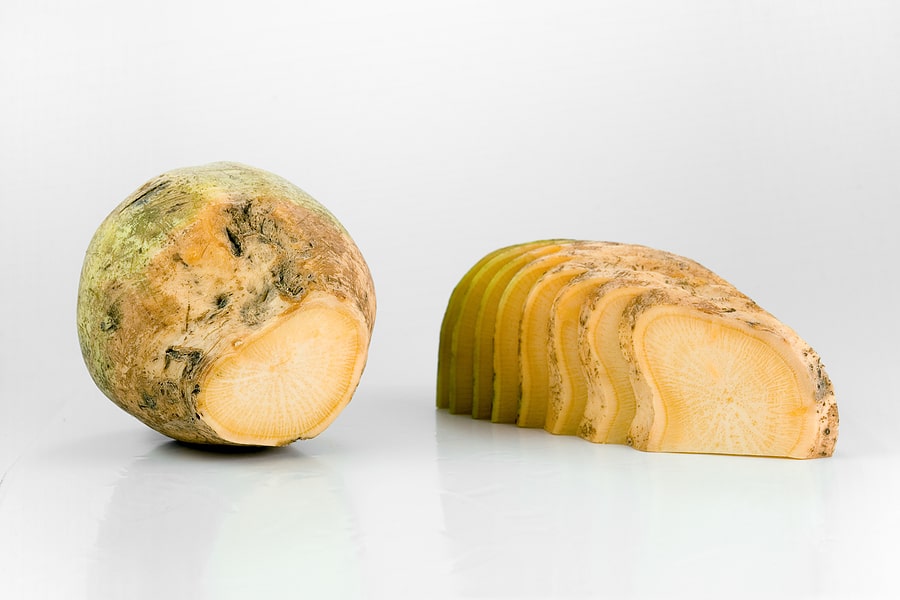
How to choose rutabaga
- Rutabagas are a cool-weather vegetable and taste best after the first frost. They store well in the ground until they are needed.
- Select rutabaga that is smooth, firm, without blemishes, and heavy for its size.
- Avoid large roots, they tend to be fibrous.
- If you smell rutabaga, the more pronounced the odor, the more pungent the flavor.
How to store rutabaga
- Rutabagas can be stored unwashed in a plastic bag in the refrigerator for up to 2 weeks.
- The leaves should be removed to prevent the root from drying out.
- You can freeze rutabagas: first, blanch for 2 minutes, cooked or purée.
Kitchen Helpers from Amazon:
- Oster Vegetable Steamer
- Chef’s Knives Set of 6
- EZ Off Jar Opener for Weak Hands
- Pepper Core Remover Stainless Steel
- Kitchen Utensils – Set of 35
How to prep rutabaga for cooking
- Scrub rutabagas under cold running water before using.
- Peel and trim if cutting into chunks or strips.
- Remove the core if it is brownish.
How to bake rutabaga
- Clean the rutabaga and trim the ends.
- Preheat the oven to 400 degrees F.
- Rub the rutabaga with olive or vegetable oil; sprinkle it with salt. Prick the tuber with the tines of a fork.
- Place the rutabaga on a baking sheet or lay it directly on the oven rack,
- Bake for 45 to 60 minutes (depending on size); turn the tuber once at halfway.
- Bake until the skin is golden and crispy; the rutabaga will be baked when a sharp knife inserted in the flesh meets no resistance. The internal temperature should be about 210 degrees F.
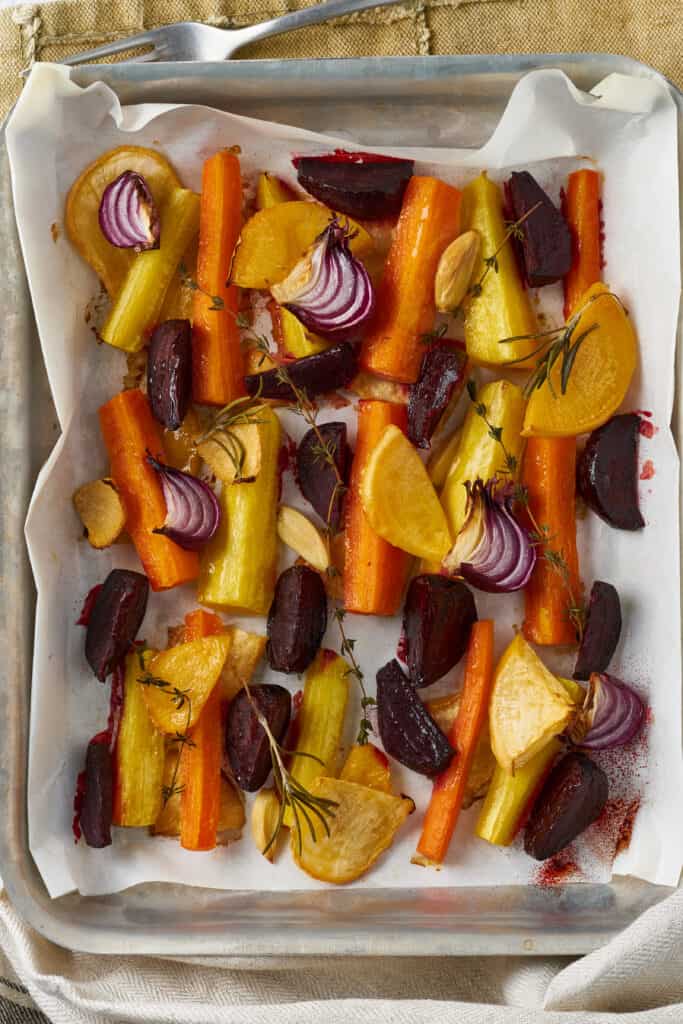
How to roast rutabaga
- Mature rutabaga should be precooked in boiling water or the microwave.
- Mature rutabagas can be roasted with the skin on or peeled. Cut matures rutabagas into thick wedges.
- Precook cut rutabagas in a microwave until soft but still firm, about 4 minutes. Or boil in salted water until tender, about 10 minutes.
- Preheat the oven to 450 degrees F.
- Spread the wedges on a pan or baking sheet and drizzle with olive oil or fat and toss well. The pieces should be evenly coated and the pan should have light, even oil across the surface.
- Season with salt, dry herbs, or spices.
- Roast 20 to 30 minutes, until bottoms are browned and a spatula slides under them smoothly.
How to boil rutabaga
- Peel and trim the rutabaga.
- Cook whole or cut the rutabaga into roughly equal size pieces, 1 or 2 inches in diameter.
- Place a whole or sliced rutabaga in a pot with water to cover and add a pinch of salt; or put in a steamer above the water.
- Add a teaspoon of sugar to give it a bit of a sweet taste.
- Bring to a boil and cook until the rutabaga is tender; about 10 minutes for cut pieces, about 35 minutes to cook whole.
How to microwave rutabaga
- Place the whole or sliced rutabaga in a covered dish.
- Sprinkle it with a bit of water.
- Cook in the microwave on high for about 10 minutes.
How to stir-fry rutabaga
- Peel and trim the rutabaga.
- Slice the rutabaga into thin strips; the smaller the pieces the faster they will cook.
- Heat 2 tablespoons of corn oil in a large, deep skillet over medium-high heat for 3 or 4 minutes.
- Add the rutabaga and a quarter cup of stock or water.
- Cook, stirring constantly, until the rutabaga is tender, about 7 minutes.
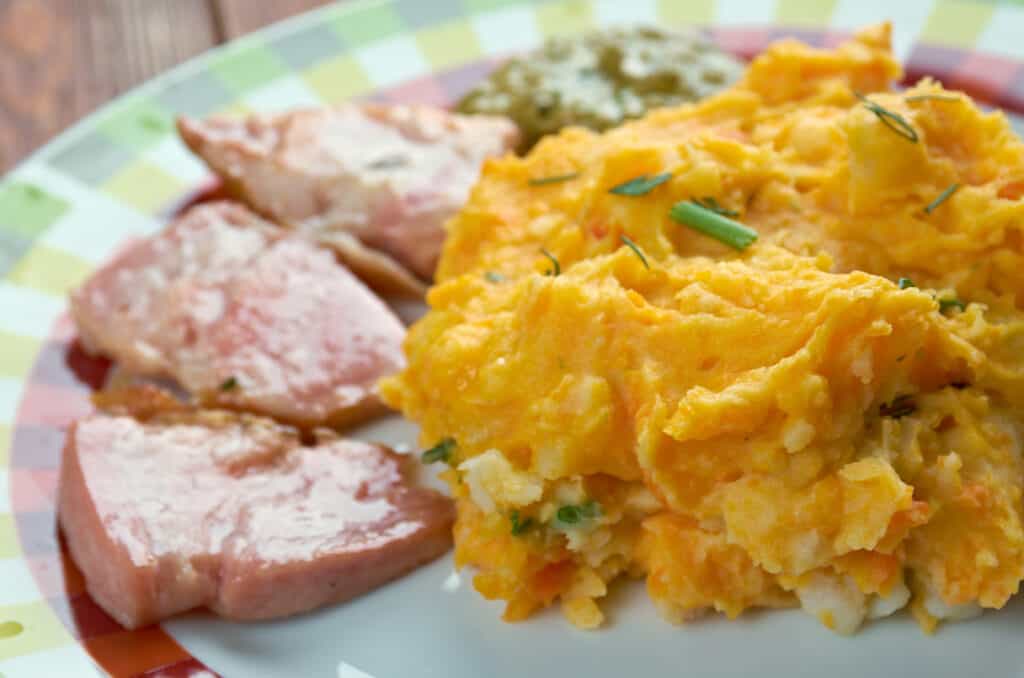
How to mash rutabaga
- Cut or dice the rutabaga into pieces and place them in a pot. Cover them with water and add a dash of salt.
- Bring the rutabaga to a boil.
- Lower the heat and let it simmer until the pieces are tender, for 15 to 40 minutes depending on the size of the pieces.
- Drain the rutabaga and mash the pieces with a potato masher.
- Work in 4 to 6 tablespoons of melted butter and season to taste with salt and pepper or a pinch of powdered nutmeg or cinnamon.
How to make rutabaga fries
- Cut rutabaga into spears or strips.
- Toss spears in olive oil along with salt and seasonings of your choice–garlic powder, dried thyme or cayenne.
- Place spears on a baking sheet or roasting pan and roast at 425 degrees F for 30 minutes.
How to make rutabaga gratin
- Preheat the oven to 400 degrees F.
- Peel the rutabagas and slice them up to 1/4-inch thick.
- Layer the slices in an ovenproof skillet almost to the top. Overlap the slices slightly nearly to the top of the skillet.
- Dot the top of the slices with 2 to 3 tablespoons butter, cut into chunks. Pour in half-and-half (or a combination of milk and cream) to come 3/4 of the way to the top (about 2 to 3 cups).
- Place the skillet on the stove and bring the liquid to a boil; reduce the heat and cook for 10 minutes, until the liquid level drops.
- Place the skillet in the oven and bake until the top browns, 10 minutes.
- Reduce the heat to 300 degrees F and garnish the top with grated cheese (Cheddar, Gruyère, Parmesan). Cook 10 minutes more or until tender and browned.
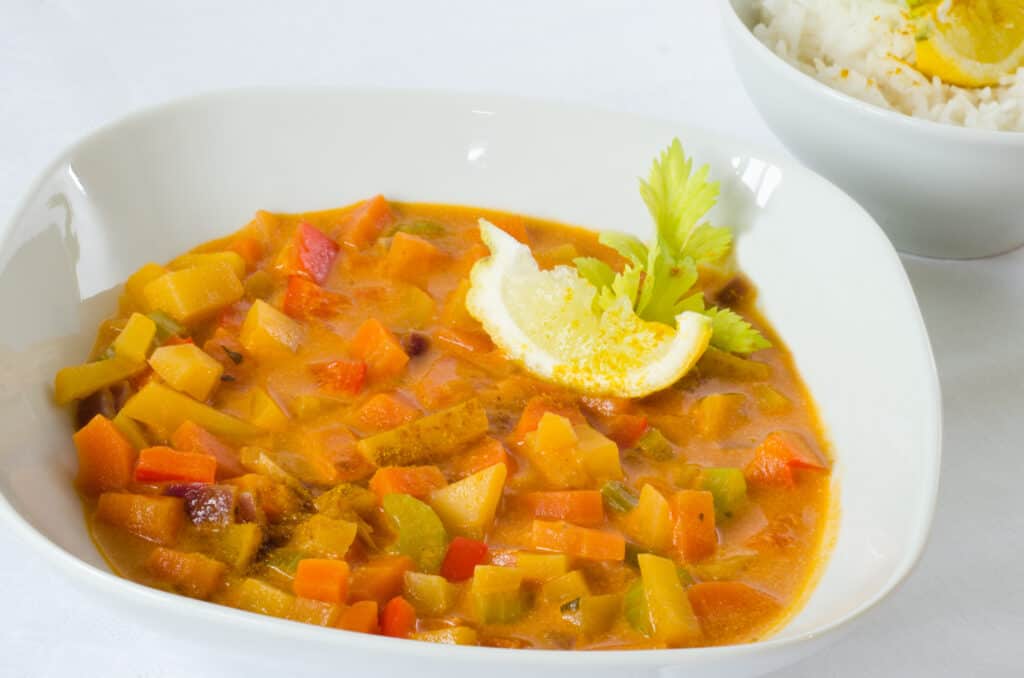
Rutabaga serving suggestions
- Serve rutabagas raw or cooked like you would turnips. Rutabagas can replace turnips in recipes.
- Shred or julienne new crop rutabagas to serve raw or marinated in salads.
- Use rutabagas in stews and soups. Allow 15 minutes for boiling and slightly longer—5 to 10 minutes–for steaming. Simmer rutabagas whole or sliced in a covered container for 20 to 40 minutes until tender—older roots may take longer.
- Purée rutabagas on their own or mix them with mashed potatoes and carrots.
- Sauté or stir-fry rutabagas without a coating or batter for 10 to 15 minutes or until they are tender and slightly browned.
- To reduce the pungency of rutabagas blanch for about 5 minutes before cooking.
- Serve rutabagas alone or mixed with greens, beans, peas, broccoli, mushrooms, celery, bacon, ham, or a combination of these.
- Serve rutabagas plain with butter or margarine, vinegar, or vinaigrette dressing.
- Season rutabagas with salt, pepper, dill, onion, garlic, marjoram, tarragon, savory, mustard, mace, nutmeg, allspice, cinnamon, cloves, ginger, mint, bay leaf, anise, caraway seed, parsley, sage, rosemary, or thyme.
- Steam rutabaga greens like mustard or turnip greens and add to leafy green salads.
Rutabaga nutrition
- Rutabagas contain a small amount of vitamins A and C.
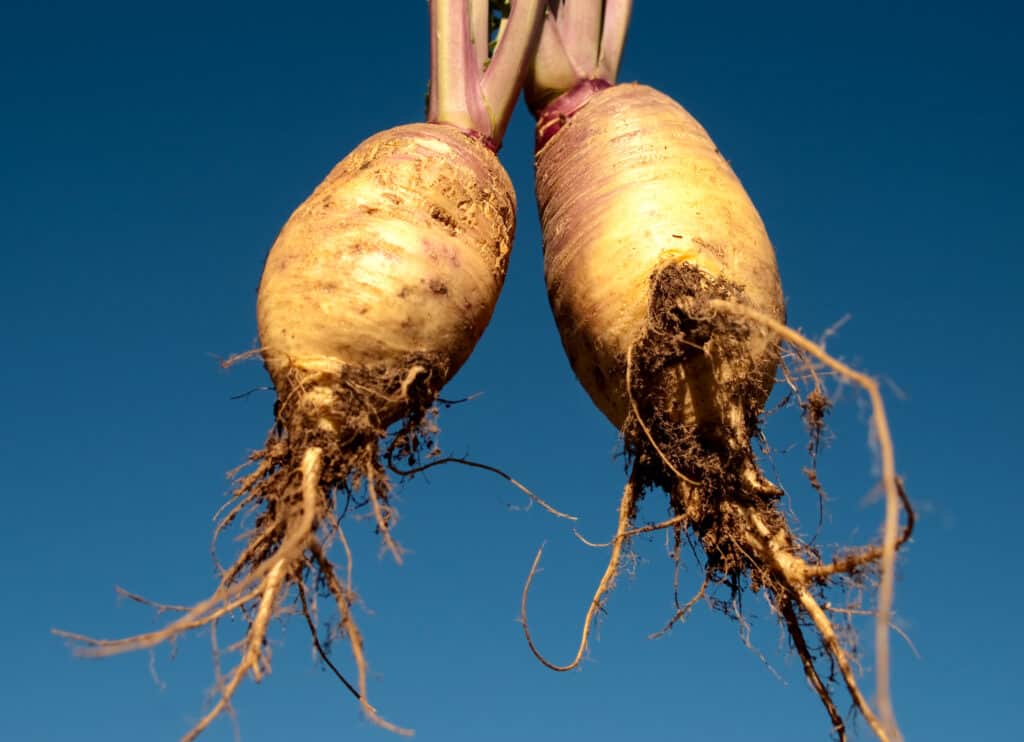
Get to know rutabaga
- The rutabaga can be treated like a turnip in the kitchen—boiled, steamed, mashed, roasted, baked, and fried. When it’s served it will taste just a bit spicier than a turnip.
- Rutabagas look something like turnips—round and slightly squat–but they usually grow larger—3 to 5 inches (7.5-13 cm) in diameter. Rutabagas often reach 3-5 pounds (1.1-1.8 kg), much larger than a turnip.
- The skin of the rutabaga root is yellow deepening to purple at the top. You will know it’s rutabaga and not a turnip by the leaf scars on its top.
- A rosette of smooth, grayish-green leaves grows from the rutabaga’s swollen stem. They grow larger and fleshier, and they are more deeply lobed than turnip leaves.
- The rutabaga’s skin is thin and its flesh is firm and pale- to golden yellow, although there is also a white-fleshed variety of rutabaga.
- The rutabaga is thought to have gotten its start in Northern European gardens sometime during the Middle Ages as a spontaneous cross between a cabbage and a turnip.
- The rutabaga was eaten in France and southern Europe during the sixteenth century and was grown in Britain as early as the fifteenth century.
- The rutabaga takes its English name from the Swedish word for the same plant rotabagge. The rutabaga is also known in English-speaking countries as Swede and Swedish turnip.
The botanical name for the rutabaga is Brassica napus.
Rutabaga articles at Harvest to Table:
How to Plant and Grow Rutabaga
How to Harvest and Store Rutabaga
Turnip, Rutabaga, Kohlrabi Growing Problems: Troubleshooting
Articles of interest:
Best Herbs for Container Growing
Garden Planning Books at Amazon:
- Vegetable Garden Almanac & Planner
- Kitchen Garden Grower’s Guide Vegetable Encyclopedia
- Vegetable Garden Grower’s Guide
- Tomato Grower’s Answer Book
More kitchen tips:
Bring your harvest to the table. Kitchen prep tips and easy recipes for the vegetables you grow. Click below for vegetable prep and recipes you can use now.
- Almonds
- Apples
- Apricot
- Aprium
- Artichoke
- Arugula
- Asparagus
- Avocado
- Bamboo Shoots
- Banana
- Basil
- Beans, Dried
- Beans. Long
- Beans, Shell
- Beans, Snap
- Beets
- Bitter Melon
- Blackberry
- Bok Choy
- Broccoli
- Broccoli Raab
- Brussels Sprouts
- Cabbage
- Cardoon
- Carrots
- Cauliflower
- Celeriac
- Celery
- Chard
- Chayote Squash
- Cherimoya
- Cherries
- Chestnut
- Chickpea
- Chinese Cabbage
- Chives
- Cilantro
- Citron
- Clementine
- Collards
- Coriander
- Corn, Sweet
- Corn, Baby
- Corn Salad, Mache
- Cranberry
- Cress
- Cucumber
- Daikon
- Dandelion
- Dill
- Eggplant
- Endive, Belgian
- Endive and Escarole
- Fava Beans
- Fig
- Florence Fennel
- Garlic
- Ginger
- Grapefruit
- Grapes
- Guava
- Horseradish
- Jerusalem Artichoke
- Jicama
- Jujube
- Kale
- Kiwifruit
- Kohlrabi
- Kumquat
- Leeks
- Lemongrass
- Lemons
- Lettuce
- Lime
- Mache (Corn Salad)
- Mandarin Orange
- Mango
- Maple Syrup
- Marjoram
- Melons
- Michihili
- Mint
- Mizuna
- Mushrooms
- Mushrooms, Cremini
- Mustard Greens
- Napa Cabbage
- Nectarine
- Okra
- Olives
- Olive oil
- Onions
- Oranges
- Oregano
- Parsley
- Parsley Root
- Parsnips
- Passion Fruit
- Pawpaw
- Peaches
- Pears
- Peas, Garden Snap
- Peas, Snow
- Pei Tsai
- Peppers, Chili
- Peppers, Sweet
- Persimmon
- Pineapple
- Pineapple Guava
- Plantain
- Plums
- Pluots
- Pomegranate
- Potatoes
- Prickly Pear
- Pumpkin
- Quince
- Radicchio
- Radishes
- Raspberries
- Rosemary
- Rhubarb
- Rutabaga
- Sage
- Salsify
- Sauerkraut
- Savory
- Shallots
- Sorrel
- Spinach
- Squash, Summer
- Squash, Winter
- Strawberries
- Sunchokes
- Sunflower
- Sweet Potato
- Swiss Chard
- Tangerine
- Taro
- Tarragon
- Thyme
- Tomatillo
- Tomato
- Turnip
- Turnip Greens
- Yams















